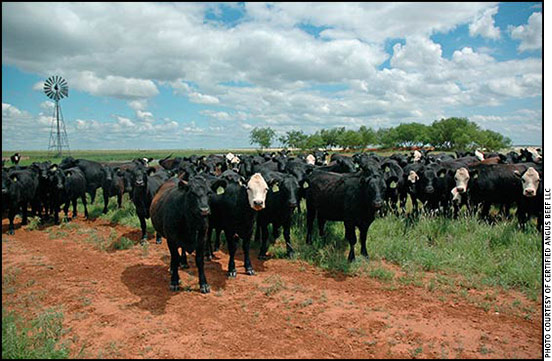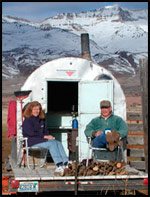MANAGEMENT...

Breed What You Need
Traditional recommendations may not fit your ranch business goals.
This is an era where you can customize virtually anything imaginable, from license plates and jewelry to M&Ms and burgers. As the beef industry moves forward, will customized breeding plans become more common?
“I teach students to develop a breed-utilization plan based on their marketing objectives,” says Joe Cassady, animal scientist at North Carolina State University. “The decision regarding the use of straightbreeding versus crossbreeding should be based on marketing objectives and maximizing profits.”
For decades, industry and academia have pointed to crossbreeding and hybrid vigor as one of the easiest strategies available to boost earnings. But a new discussion is emerging.
“Profit should be based on net return on assets. That requires a good understanding of costs of production,” he says. Read more.

Ron Torell with his wife, Jackie
Cow Camp Chatter
Shop for nutrients.
Hay prices are skyrocketing. In some instances the price has doubled from what it was just a few short years ago. These escalating prices are primarily due to a nationwide drought that has reduced supply and increased demand for hay, grain and standing forage. The price relationship of protein and energy sources parallel corn and other grain commodities.
Whether you are selling, purchasing or feeding hay, it is important to know what you are dealing with. The best and most appropriate way to accomplish this is to compare price per pound of nutrient, not price per ton of feed. This is when an accurate forage/hay sample and analysis will save/earn you valuable dollars. Read more.

Kris Ringwall
Beef Talk
Am I short of feed or short of cash?
Today, cattle producers market cows and bulls in much the same way they market the annual production of calves.
However, here is something to keep in mind: If a typical beef producer marketed all the cattle last week that normally would be sold off the operation, approximately 50% of the check would be from the value of steer calves, 30% from the value of heifer calves and 20% from the value of market cows and bulls.
Let me explain by re-examining the 2011 production year benchmarks from those producers involved with the North Dakota Beef Cattle Improvement Association (NDBCIA).
Let’s assume a typical producer exposed 100 cows to the bull. The producer would have 91 calves in the fall. If the male-to-female ratio was 45 steers and 46 heifers, this producer would have approximately 25,740 pounds (lb.) of steers (572 lb. per steer) to market and 25,070 lb. of heifers (545 lb. per heifer) available as replacements or to market. Read more.
Winter Bull Management
Fall and winter management of bulls is important to prepare them to be healthy and in top shape for next year’s breeding season. Ken Dunn, an Idaho Angus breeder near Tetonia, says one of the important considerations in regions with cold winters is to recognize the potential for frostbitten testicles, especially if there’s wind.
“Bulls need a place where they can get out of the wind and ideally have straw to lie in,” he says. In his bull pens, he creates mounds of piled straw. If you keep adding straw to the pile, the straw mixed with manure tends to ferment and generate heat. Read more.
The Impact of Feed Efficiency
With feed costs representing two-thirds or more of total production inputs, improvements to feed efficiency can have dramatic impacts on profitability.
 During the opening session of the 2012 National Angus Conference in Wichita, Kan., animal scientists Daryl Strohbehn and Bob Weaber discussed the beef industry’s approach to improving feed efficiency. Strohbehn, recently retired from Iowa State University, initiated the tag-team presentation by recalling a 1984 efficiency forum where Michigan State University’s Harlan Ritchie had issued a warning to the industry.
During the opening session of the 2012 National Angus Conference in Wichita, Kan., animal scientists Daryl Strohbehn and Bob Weaber discussed the beef industry’s approach to improving feed efficiency. Strohbehn, recently retired from Iowa State University, initiated the tag-team presentation by recalling a 1984 efficiency forum where Michigan State University’s Harlan Ritchie had issued a warning to the industry.
“Dr. Ritchie said we needed to identify ways to improve beef cow efficiency,” noted Strohbehn. “But really, have we accomplished anything on the cow side in 28 years?” Read more.
A Paradigm Shift for Young Cattle Producers
University of Kentucky professor offers changing areas of cattle production for young producers.
A paradigm shift is a change in your way of thinking that doesn’t just happen but is driven by agents of change. Young cattle producers will have to deal with these “agents of change” in ways that we could not have imagined a generation ago. In my opinion, some of these changes are in multiple areas. Read more.
New Products
Industry affiliates provide a wide array of products and services to assist you on the farm and ranch. Here's an assortment of new products to hit the market recently.
- Body condition score app
- Third e-book released
- Self-propelled forage harvesters with new technologies
- Gas-powered post driver
What Can You Learn From Gains This Summer?
Variety of factors may have caused stocker gains to decline, according to extension livestock specialist. Did you take notes?
Some Ozarks cattle producers raising stocker steers are reporting smaller-than-average gains this year despite not making any drastic operational changes. According to Eldon Cole, a livestock specialist with University of Missouri (MU) Extension, many factors could have been at work to reduce gains.
“The most obvious would be the weather. Hot weather the last two years likely has resulted in lower animal performance. The hot, dry summers probably reduced the percentage of legume in the pastures, thus lowering gains,” said Cole. Read more.
Angus Advisor
Click here for November herd management tips from cattle experts across the nation. Advice separated by region.
[Click here to go to the top of the page.]











